Healthcare Professional: Critical Incident and Action Plan Report
VerifiedAdded on 2020/05/28
|10
|2978
|73
Report
AI Summary
This report details a critical incident experienced by a healthcare professional during a group presentation, involving a pregnancy-related hospitalization. The report outlines the incident, the challenges faced, and the impact on the student's studies and perception of the healthcare environment. It includes a reflective analysis of the emotional and professional consequences of the event, including feelings of embarrassment and the development of confidence and communication skills. Furthermore, the report proposes a detailed action plan for improvement, involving the formation of a change team, problem definition, aim definition, intervention design, and implementation strategy. The plan focuses on improving workplace performance, patient data safety, and enhancing the skills of healthcare professionals. The report concludes by highlighting the importance of the incident in shaping the student's future practice, emphasizing the value of communication skills, cultural understanding, and teamwork in providing high-quality patient care. The report emphasizes that healthcare professionals must have the capability of expressing his/her opinions and ideal confidently and apparently without any contradictions. The confidence which the student developed in communication and understanding of different cultures was to enable the patients to have a high trust in the student.
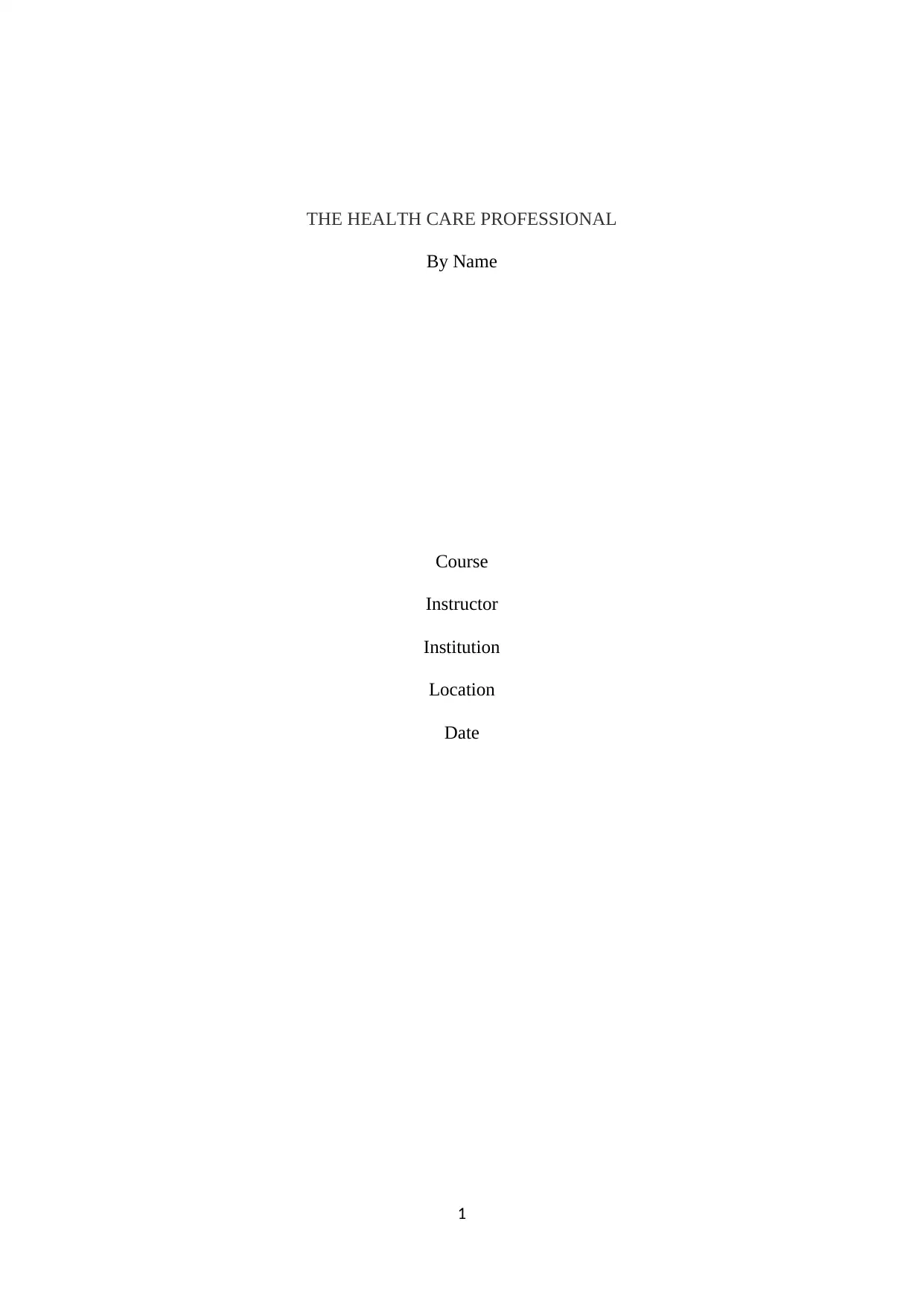
THE HEALTH CARE PROFESSIONAL
By Name
Course
Instructor
Institution
Location
Date
1
By Name
Course
Instructor
Institution
Location
Date
1
Secure Best Marks with AI Grader
Need help grading? Try our AI Grader for instant feedback on your assignments.
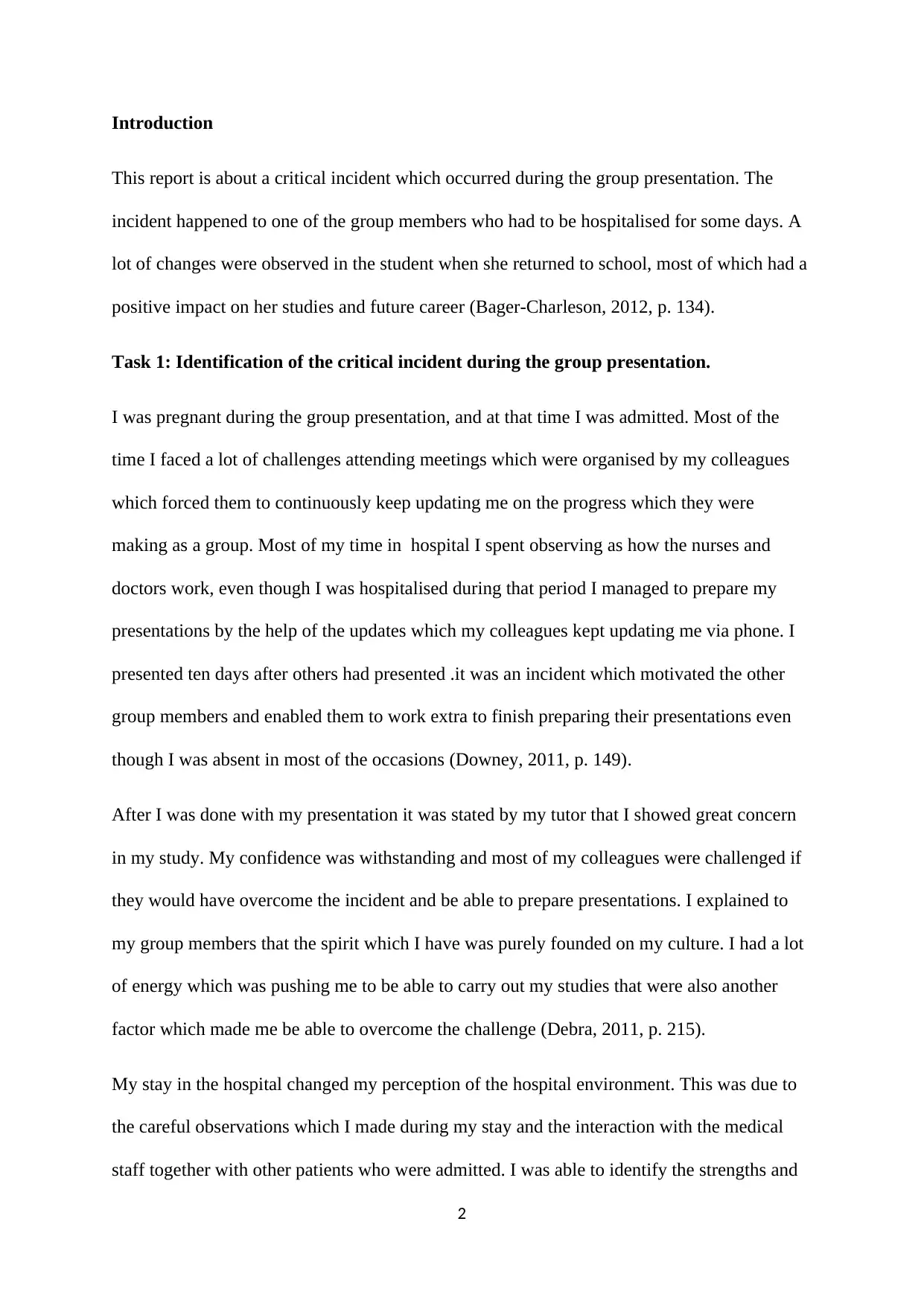
Introduction
This report is about a critical incident which occurred during the group presentation. The
incident happened to one of the group members who had to be hospitalised for some days. A
lot of changes were observed in the student when she returned to school, most of which had a
positive impact on her studies and future career (Bager-Charleson, 2012, p. 134).
Task 1: Identification of the critical incident during the group presentation.
I was pregnant during the group presentation, and at that time I was admitted. Most of the
time I faced a lot of challenges attending meetings which were organised by my colleagues
which forced them to continuously keep updating me on the progress which they were
making as a group. Most of my time in hospital I spent observing as how the nurses and
doctors work, even though I was hospitalised during that period I managed to prepare my
presentations by the help of the updates which my colleagues kept updating me via phone. I
presented ten days after others had presented .it was an incident which motivated the other
group members and enabled them to work extra to finish preparing their presentations even
though I was absent in most of the occasions (Downey, 2011, p. 149).
After I was done with my presentation it was stated by my tutor that I showed great concern
in my study. My confidence was withstanding and most of my colleagues were challenged if
they would have overcome the incident and be able to prepare presentations. I explained to
my group members that the spirit which I have was purely founded on my culture. I had a lot
of energy which was pushing me to be able to carry out my studies that were also another
factor which made me be able to overcome the challenge (Debra, 2011, p. 215).
My stay in the hospital changed my perception of the hospital environment. This was due to
the careful observations which I made during my stay and the interaction with the medical
staff together with other patients who were admitted. I was able to identify the strengths and
2
This report is about a critical incident which occurred during the group presentation. The
incident happened to one of the group members who had to be hospitalised for some days. A
lot of changes were observed in the student when she returned to school, most of which had a
positive impact on her studies and future career (Bager-Charleson, 2012, p. 134).
Task 1: Identification of the critical incident during the group presentation.
I was pregnant during the group presentation, and at that time I was admitted. Most of the
time I faced a lot of challenges attending meetings which were organised by my colleagues
which forced them to continuously keep updating me on the progress which they were
making as a group. Most of my time in hospital I spent observing as how the nurses and
doctors work, even though I was hospitalised during that period I managed to prepare my
presentations by the help of the updates which my colleagues kept updating me via phone. I
presented ten days after others had presented .it was an incident which motivated the other
group members and enabled them to work extra to finish preparing their presentations even
though I was absent in most of the occasions (Downey, 2011, p. 149).
After I was done with my presentation it was stated by my tutor that I showed great concern
in my study. My confidence was withstanding and most of my colleagues were challenged if
they would have overcome the incident and be able to prepare presentations. I explained to
my group members that the spirit which I have was purely founded on my culture. I had a lot
of energy which was pushing me to be able to carry out my studies that were also another
factor which made me be able to overcome the challenge (Debra, 2011, p. 215).
My stay in the hospital changed my perception of the hospital environment. This was due to
the careful observations which I made during my stay and the interaction with the medical
staff together with other patients who were admitted. I was able to identify the strengths and
2
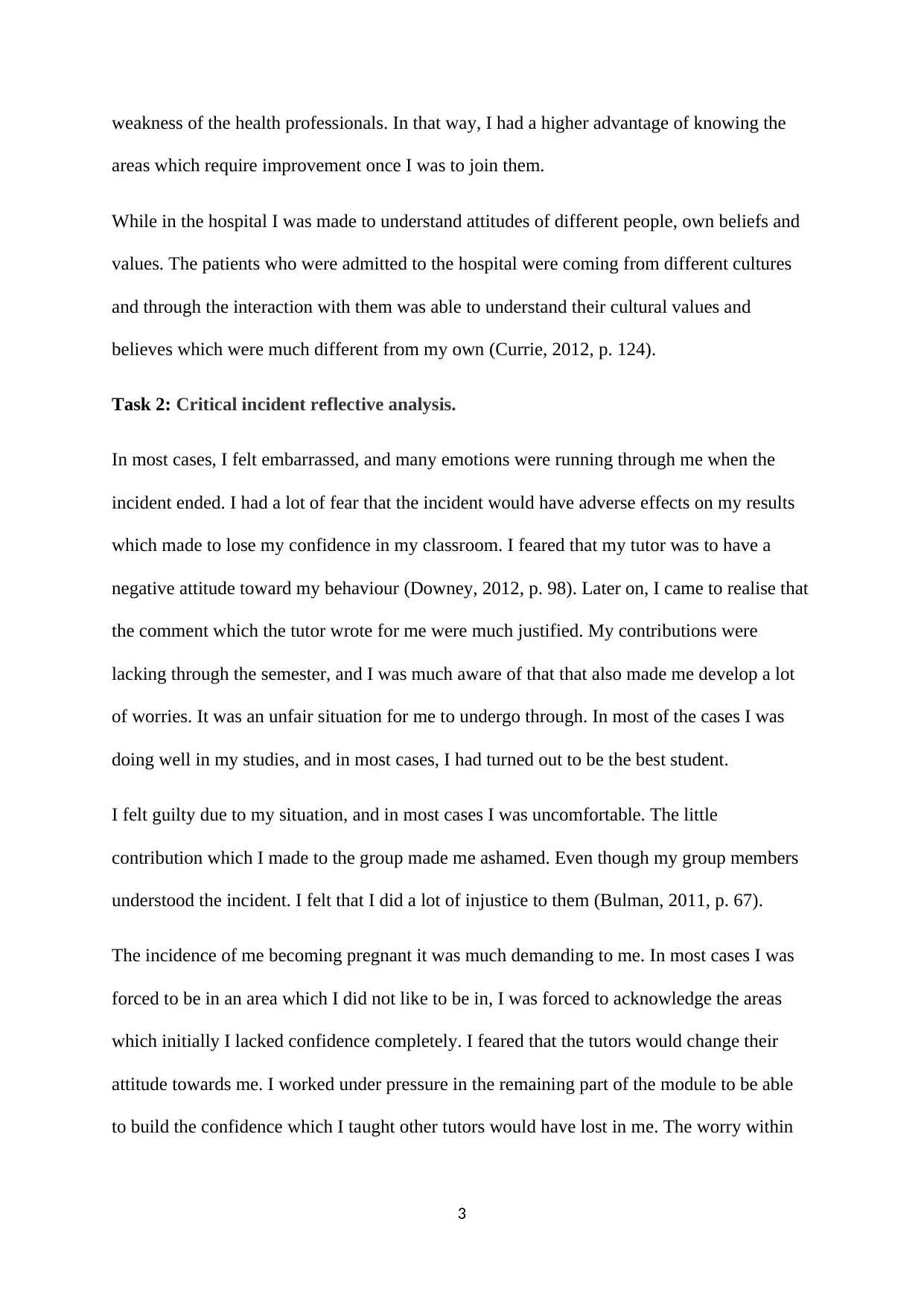
weakness of the health professionals. In that way, I had a higher advantage of knowing the
areas which require improvement once I was to join them.
While in the hospital I was made to understand attitudes of different people, own beliefs and
values. The patients who were admitted to the hospital were coming from different cultures
and through the interaction with them was able to understand their cultural values and
believes which were much different from my own (Currie, 2012, p. 124).
Task 2: Critical incident reflective analysis.
In most cases, I felt embarrassed, and many emotions were running through me when the
incident ended. I had a lot of fear that the incident would have adverse effects on my results
which made to lose my confidence in my classroom. I feared that my tutor was to have a
negative attitude toward my behaviour (Downey, 2012, p. 98). Later on, I came to realise that
the comment which the tutor wrote for me were much justified. My contributions were
lacking through the semester, and I was much aware of that that also made me develop a lot
of worries. It was an unfair situation for me to undergo through. In most of the cases I was
doing well in my studies, and in most cases, I had turned out to be the best student.
I felt guilty due to my situation, and in most cases I was uncomfortable. The little
contribution which I made to the group made me ashamed. Even though my group members
understood the incident. I felt that I did a lot of injustice to them (Bulman, 2011, p. 67).
The incidence of me becoming pregnant it was much demanding to me. In most cases I was
forced to be in an area which I did not like to be in, I was forced to acknowledge the areas
which initially I lacked confidence completely. I feared that the tutors would change their
attitude towards me. I worked under pressure in the remaining part of the module to be able
to build the confidence which I taught other tutors would have lost in me. The worry within
3
areas which require improvement once I was to join them.
While in the hospital I was made to understand attitudes of different people, own beliefs and
values. The patients who were admitted to the hospital were coming from different cultures
and through the interaction with them was able to understand their cultural values and
believes which were much different from my own (Currie, 2012, p. 124).
Task 2: Critical incident reflective analysis.
In most cases, I felt embarrassed, and many emotions were running through me when the
incident ended. I had a lot of fear that the incident would have adverse effects on my results
which made to lose my confidence in my classroom. I feared that my tutor was to have a
negative attitude toward my behaviour (Downey, 2012, p. 98). Later on, I came to realise that
the comment which the tutor wrote for me were much justified. My contributions were
lacking through the semester, and I was much aware of that that also made me develop a lot
of worries. It was an unfair situation for me to undergo through. In most of the cases I was
doing well in my studies, and in most cases, I had turned out to be the best student.
I felt guilty due to my situation, and in most cases I was uncomfortable. The little
contribution which I made to the group made me ashamed. Even though my group members
understood the incident. I felt that I did a lot of injustice to them (Bulman, 2011, p. 67).
The incidence of me becoming pregnant it was much demanding to me. In most cases I was
forced to be in an area which I did not like to be in, I was forced to acknowledge the areas
which initially I lacked confidence completely. I feared that the tutors would change their
attitude towards me. I worked under pressure in the remaining part of the module to be able
to build the confidence which I taught other tutors would have lost in me. The worry within
3
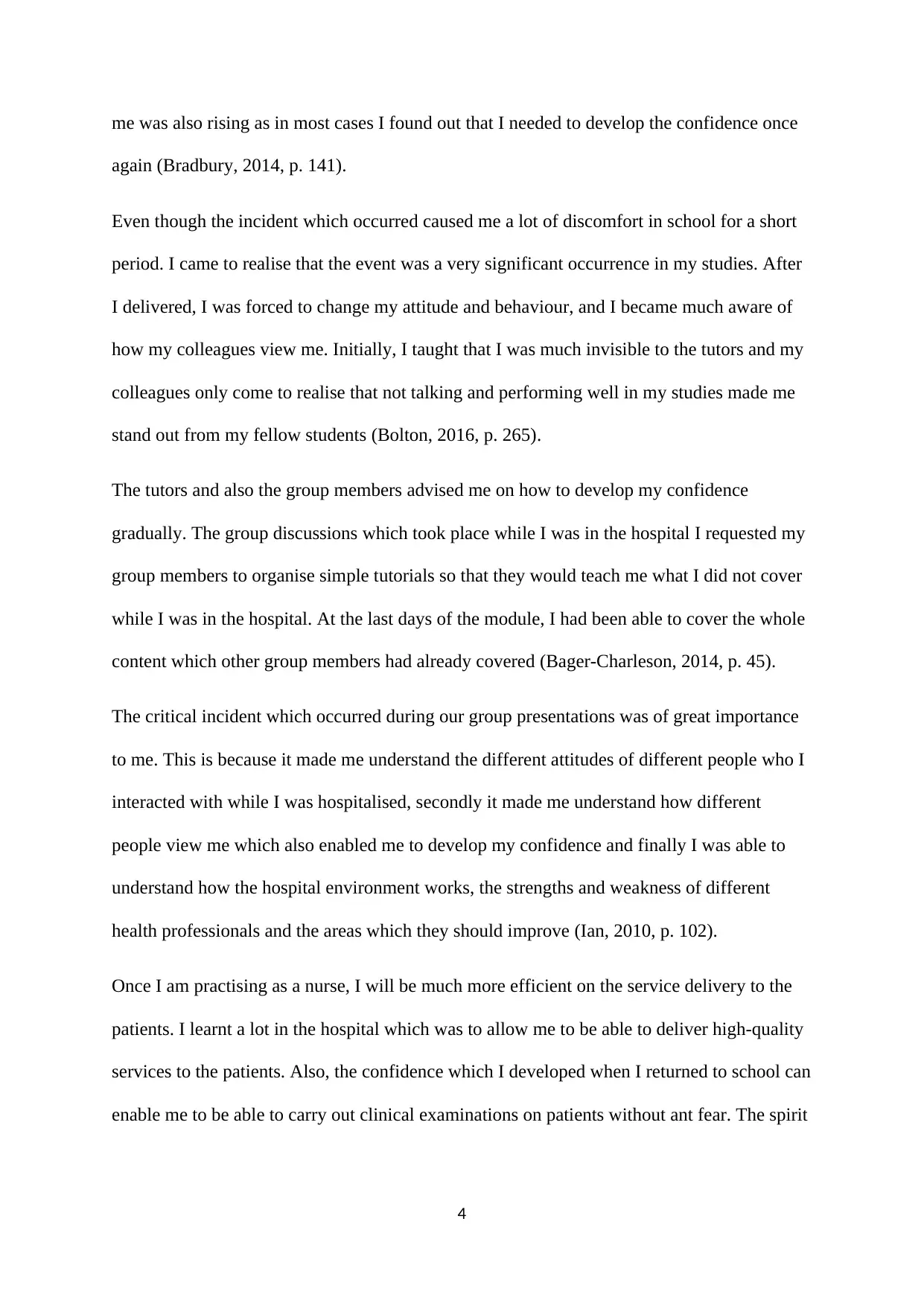
me was also rising as in most cases I found out that I needed to develop the confidence once
again (Bradbury, 2014, p. 141).
Even though the incident which occurred caused me a lot of discomfort in school for a short
period. I came to realise that the event was a very significant occurrence in my studies. After
I delivered, I was forced to change my attitude and behaviour, and I became much aware of
how my colleagues view me. Initially, I taught that I was much invisible to the tutors and my
colleagues only come to realise that not talking and performing well in my studies made me
stand out from my fellow students (Bolton, 2016, p. 265).
The tutors and also the group members advised me on how to develop my confidence
gradually. The group discussions which took place while I was in the hospital I requested my
group members to organise simple tutorials so that they would teach me what I did not cover
while I was in the hospital. At the last days of the module, I had been able to cover the whole
content which other group members had already covered (Bager-Charleson, 2014, p. 45).
The critical incident which occurred during our group presentations was of great importance
to me. This is because it made me understand the different attitudes of different people who I
interacted with while I was hospitalised, secondly it made me understand how different
people view me which also enabled me to develop my confidence and finally I was able to
understand how the hospital environment works, the strengths and weakness of different
health professionals and the areas which they should improve (Ian, 2010, p. 102).
Once I am practising as a nurse, I will be much more efficient on the service delivery to the
patients. I learnt a lot in the hospital which was to allow me to be able to deliver high-quality
services to the patients. Also, the confidence which I developed when I returned to school can
enable me to be able to carry out clinical examinations on patients without ant fear. The spirit
4
again (Bradbury, 2014, p. 141).
Even though the incident which occurred caused me a lot of discomfort in school for a short
period. I came to realise that the event was a very significant occurrence in my studies. After
I delivered, I was forced to change my attitude and behaviour, and I became much aware of
how my colleagues view me. Initially, I taught that I was much invisible to the tutors and my
colleagues only come to realise that not talking and performing well in my studies made me
stand out from my fellow students (Bolton, 2016, p. 265).
The tutors and also the group members advised me on how to develop my confidence
gradually. The group discussions which took place while I was in the hospital I requested my
group members to organise simple tutorials so that they would teach me what I did not cover
while I was in the hospital. At the last days of the module, I had been able to cover the whole
content which other group members had already covered (Bager-Charleson, 2014, p. 45).
The critical incident which occurred during our group presentations was of great importance
to me. This is because it made me understand the different attitudes of different people who I
interacted with while I was hospitalised, secondly it made me understand how different
people view me which also enabled me to develop my confidence and finally I was able to
understand how the hospital environment works, the strengths and weakness of different
health professionals and the areas which they should improve (Ian, 2010, p. 102).
Once I am practising as a nurse, I will be much more efficient on the service delivery to the
patients. I learnt a lot in the hospital which was to allow me to be able to deliver high-quality
services to the patients. Also, the confidence which I developed when I returned to school can
enable me to be able to carry out clinical examinations on patients without ant fear. The spirit
4
Secure Best Marks with AI Grader
Need help grading? Try our AI Grader for instant feedback on your assignments.
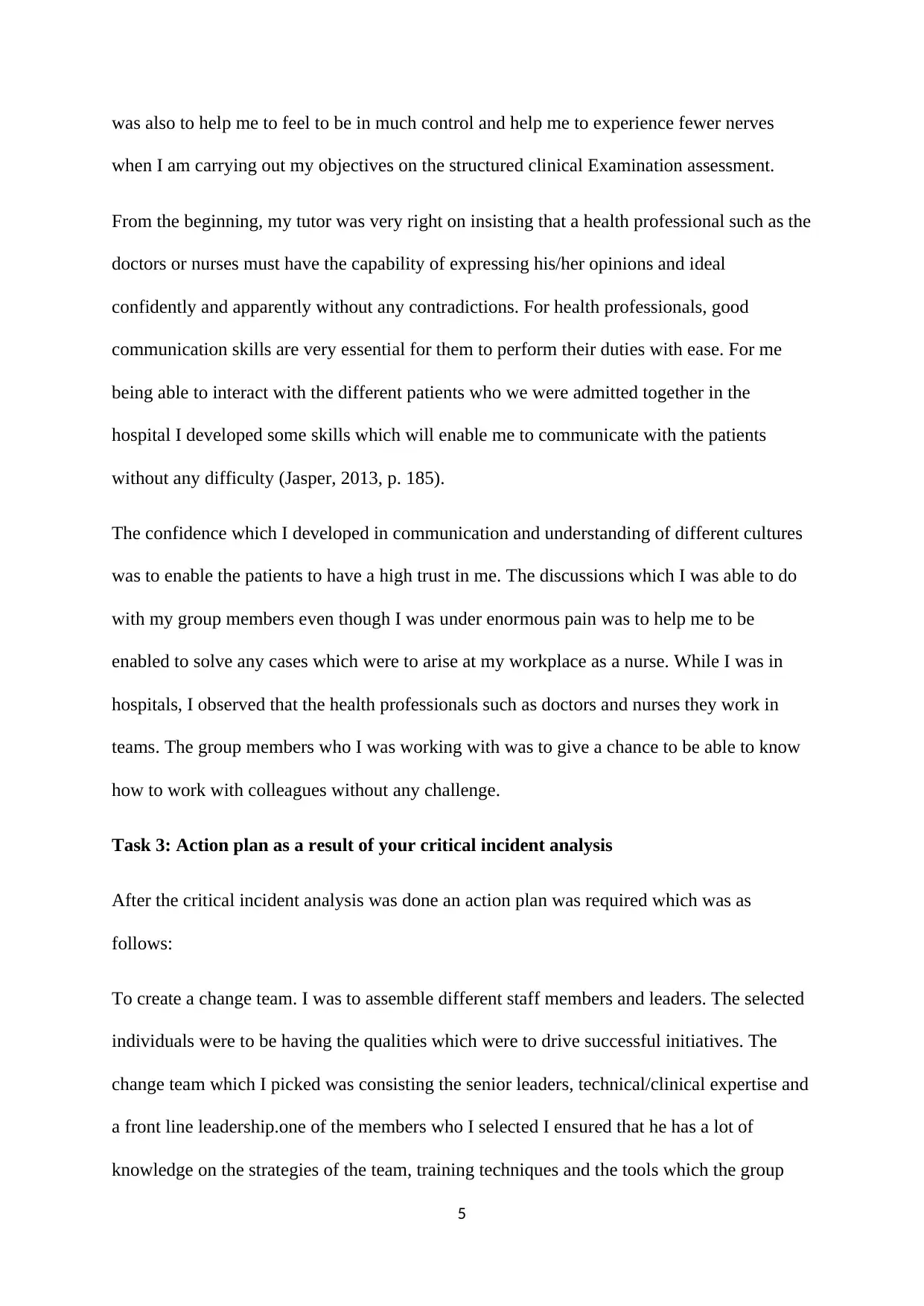
was also to help me to feel to be in much control and help me to experience fewer nerves
when I am carrying out my objectives on the structured clinical Examination assessment.
From the beginning, my tutor was very right on insisting that a health professional such as the
doctors or nurses must have the capability of expressing his/her opinions and ideal
confidently and apparently without any contradictions. For health professionals, good
communication skills are very essential for them to perform their duties with ease. For me
being able to interact with the different patients who we were admitted together in the
hospital I developed some skills which will enable me to communicate with the patients
without any difficulty (Jasper, 2013, p. 185).
The confidence which I developed in communication and understanding of different cultures
was to enable the patients to have a high trust in me. The discussions which I was able to do
with my group members even though I was under enormous pain was to help me to be
enabled to solve any cases which were to arise at my workplace as a nurse. While I was in
hospitals, I observed that the health professionals such as doctors and nurses they work in
teams. The group members who I was working with was to give a chance to be able to know
how to work with colleagues without any challenge.
Task 3: Action plan as a result of your critical incident analysis
After the critical incident analysis was done an action plan was required which was as
follows:
To create a change team. I was to assemble different staff members and leaders. The selected
individuals were to be having the qualities which were to drive successful initiatives. The
change team which I picked was consisting the senior leaders, technical/clinical expertise and
a front line leadership.one of the members who I selected I ensured that he has a lot of
knowledge on the strategies of the team, training techniques and the tools which the group
5
when I am carrying out my objectives on the structured clinical Examination assessment.
From the beginning, my tutor was very right on insisting that a health professional such as the
doctors or nurses must have the capability of expressing his/her opinions and ideal
confidently and apparently without any contradictions. For health professionals, good
communication skills are very essential for them to perform their duties with ease. For me
being able to interact with the different patients who we were admitted together in the
hospital I developed some skills which will enable me to communicate with the patients
without any difficulty (Jasper, 2013, p. 185).
The confidence which I developed in communication and understanding of different cultures
was to enable the patients to have a high trust in me. The discussions which I was able to do
with my group members even though I was under enormous pain was to help me to be
enabled to solve any cases which were to arise at my workplace as a nurse. While I was in
hospitals, I observed that the health professionals such as doctors and nurses they work in
teams. The group members who I was working with was to give a chance to be able to know
how to work with colleagues without any challenge.
Task 3: Action plan as a result of your critical incident analysis
After the critical incident analysis was done an action plan was required which was as
follows:
To create a change team. I was to assemble different staff members and leaders. The selected
individuals were to be having the qualities which were to drive successful initiatives. The
change team which I picked was consisting the senior leaders, technical/clinical expertise and
a front line leadership.one of the members who I selected I ensured that he has a lot of
knowledge on the strategies of the team, training techniques and the tools which the group
5
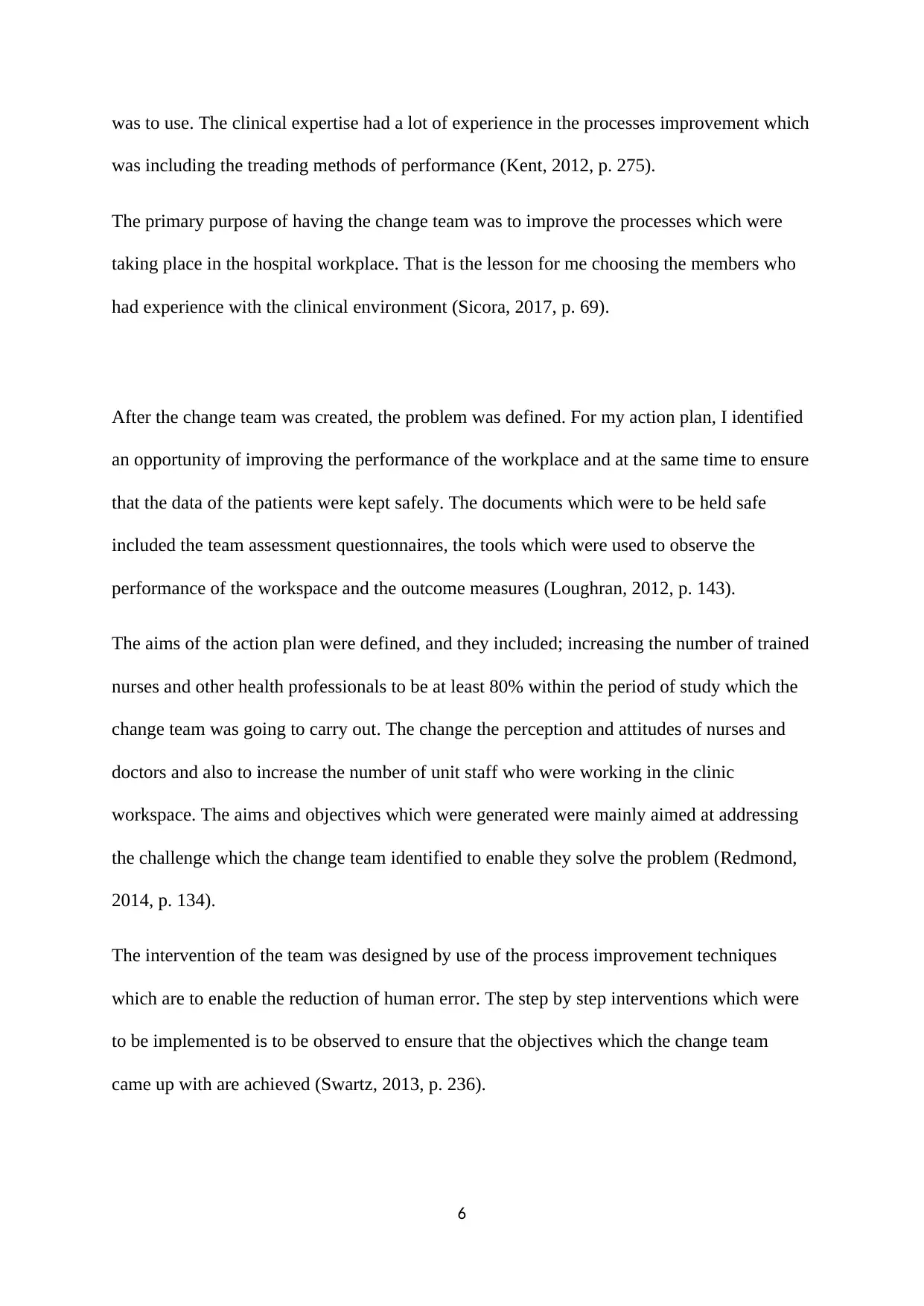
was to use. The clinical expertise had a lot of experience in the processes improvement which
was including the treading methods of performance (Kent, 2012, p. 275).
The primary purpose of having the change team was to improve the processes which were
taking place in the hospital workplace. That is the lesson for me choosing the members who
had experience with the clinical environment (Sicora, 2017, p. 69).
After the change team was created, the problem was defined. For my action plan, I identified
an opportunity of improving the performance of the workplace and at the same time to ensure
that the data of the patients were kept safely. The documents which were to be held safe
included the team assessment questionnaires, the tools which were used to observe the
performance of the workspace and the outcome measures (Loughran, 2012, p. 143).
The aims of the action plan were defined, and they included; increasing the number of trained
nurses and other health professionals to be at least 80% within the period of study which the
change team was going to carry out. The change the perception and attitudes of nurses and
doctors and also to increase the number of unit staff who were working in the clinic
workspace. The aims and objectives which were generated were mainly aimed at addressing
the challenge which the change team identified to enable they solve the problem (Redmond,
2014, p. 134).
The intervention of the team was designed by use of the process improvement techniques
which are to enable the reduction of human error. The step by step interventions which were
to be implemented is to be observed to ensure that the objectives which the change team
came up with are achieved (Swartz, 2013, p. 236).
6
was including the treading methods of performance (Kent, 2012, p. 275).
The primary purpose of having the change team was to improve the processes which were
taking place in the hospital workplace. That is the lesson for me choosing the members who
had experience with the clinical environment (Sicora, 2017, p. 69).
After the change team was created, the problem was defined. For my action plan, I identified
an opportunity of improving the performance of the workplace and at the same time to ensure
that the data of the patients were kept safely. The documents which were to be held safe
included the team assessment questionnaires, the tools which were used to observe the
performance of the workspace and the outcome measures (Loughran, 2012, p. 143).
The aims of the action plan were defined, and they included; increasing the number of trained
nurses and other health professionals to be at least 80% within the period of study which the
change team was going to carry out. The change the perception and attitudes of nurses and
doctors and also to increase the number of unit staff who were working in the clinic
workspace. The aims and objectives which were generated were mainly aimed at addressing
the challenge which the change team identified to enable they solve the problem (Redmond,
2014, p. 134).
The intervention of the team was designed by use of the process improvement techniques
which are to enable the reduction of human error. The step by step interventions which were
to be implemented is to be observed to ensure that the objectives which the change team
came up with are achieved (Swartz, 2013, p. 236).
6
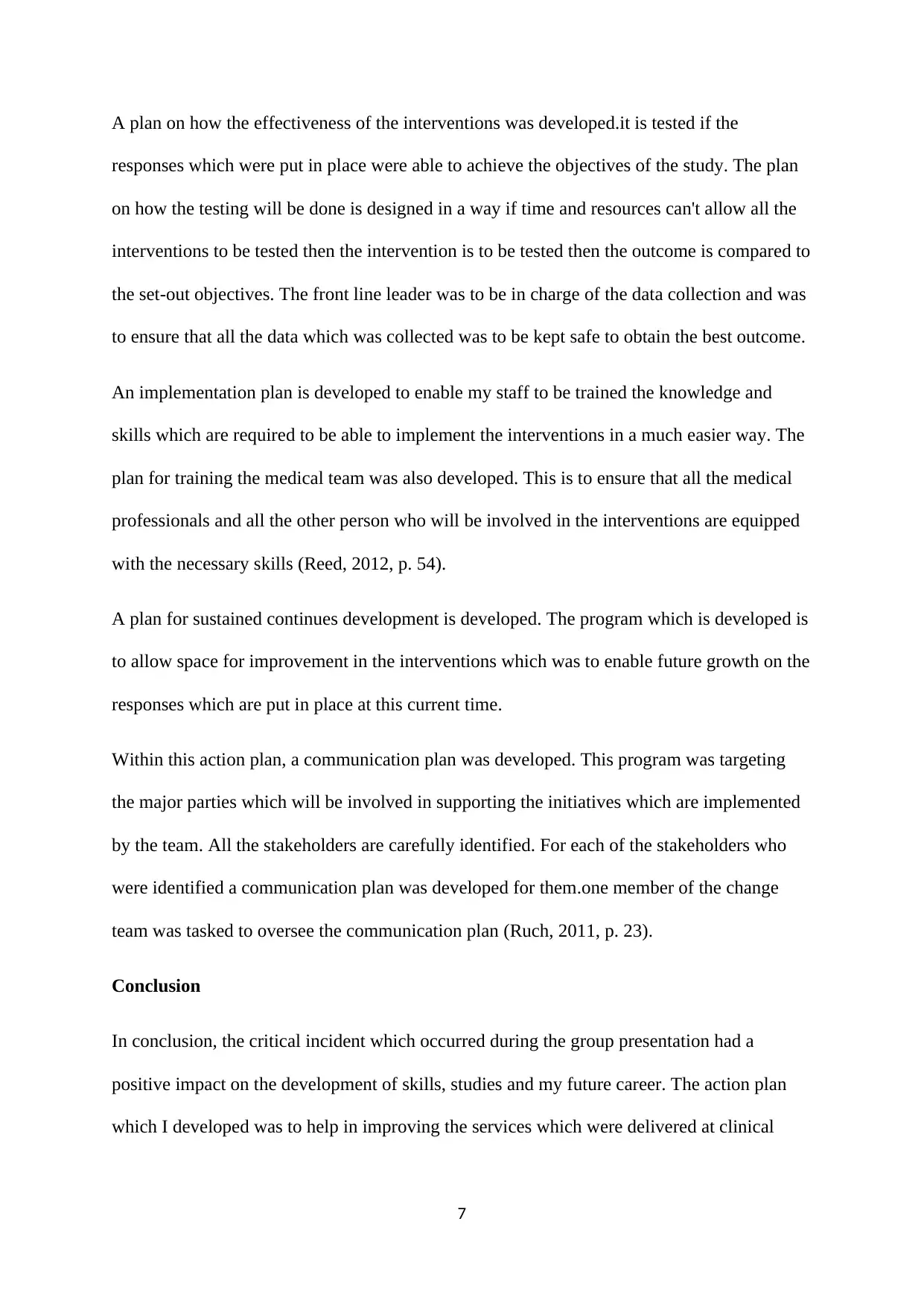
A plan on how the effectiveness of the interventions was developed.it is tested if the
responses which were put in place were able to achieve the objectives of the study. The plan
on how the testing will be done is designed in a way if time and resources can't allow all the
interventions to be tested then the intervention is to be tested then the outcome is compared to
the set-out objectives. The front line leader was to be in charge of the data collection and was
to ensure that all the data which was collected was to be kept safe to obtain the best outcome.
An implementation plan is developed to enable my staff to be trained the knowledge and
skills which are required to be able to implement the interventions in a much easier way. The
plan for training the medical team was also developed. This is to ensure that all the medical
professionals and all the other person who will be involved in the interventions are equipped
with the necessary skills (Reed, 2012, p. 54).
A plan for sustained continues development is developed. The program which is developed is
to allow space for improvement in the interventions which was to enable future growth on the
responses which are put in place at this current time.
Within this action plan, a communication plan was developed. This program was targeting
the major parties which will be involved in supporting the initiatives which are implemented
by the team. All the stakeholders are carefully identified. For each of the stakeholders who
were identified a communication plan was developed for them.one member of the change
team was tasked to oversee the communication plan (Ruch, 2011, p. 23).
Conclusion
In conclusion, the critical incident which occurred during the group presentation had a
positive impact on the development of skills, studies and my future career. The action plan
which I developed was to help in improving the services which were delivered at clinical
7
responses which were put in place were able to achieve the objectives of the study. The plan
on how the testing will be done is designed in a way if time and resources can't allow all the
interventions to be tested then the intervention is to be tested then the outcome is compared to
the set-out objectives. The front line leader was to be in charge of the data collection and was
to ensure that all the data which was collected was to be kept safe to obtain the best outcome.
An implementation plan is developed to enable my staff to be trained the knowledge and
skills which are required to be able to implement the interventions in a much easier way. The
plan for training the medical team was also developed. This is to ensure that all the medical
professionals and all the other person who will be involved in the interventions are equipped
with the necessary skills (Reed, 2012, p. 54).
A plan for sustained continues development is developed. The program which is developed is
to allow space for improvement in the interventions which was to enable future growth on the
responses which are put in place at this current time.
Within this action plan, a communication plan was developed. This program was targeting
the major parties which will be involved in supporting the initiatives which are implemented
by the team. All the stakeholders are carefully identified. For each of the stakeholders who
were identified a communication plan was developed for them.one member of the change
team was tasked to oversee the communication plan (Ruch, 2011, p. 23).
Conclusion
In conclusion, the critical incident which occurred during the group presentation had a
positive impact on the development of skills, studies and my future career. The action plan
which I developed was to help in improving the services which were delivered at clinical
7
Paraphrase This Document
Need a fresh take? Get an instant paraphrase of this document with our AI Paraphraser
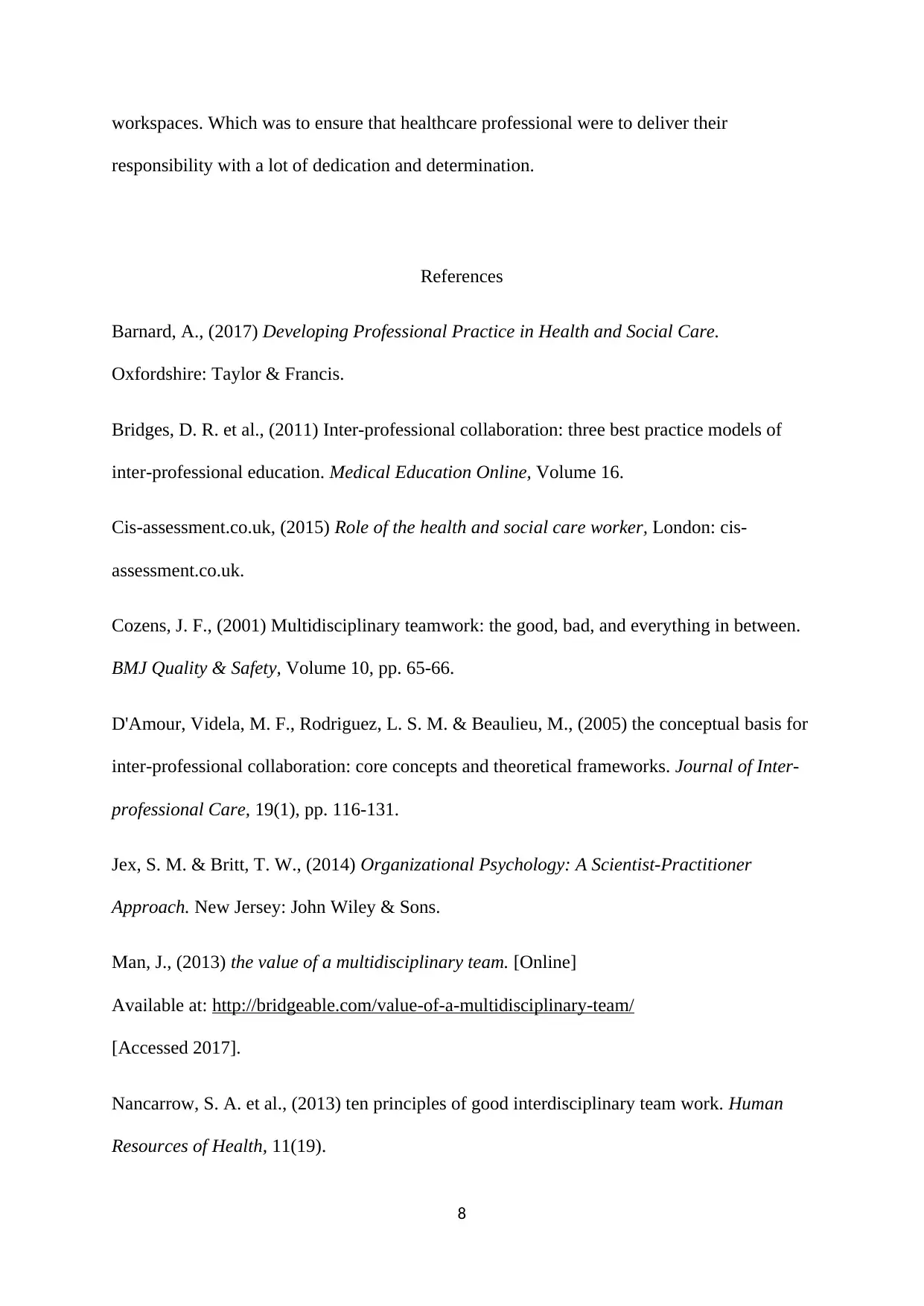
workspaces. Which was to ensure that healthcare professional were to deliver their
responsibility with a lot of dedication and determination.
References
Barnard, A., (2017) Developing Professional Practice in Health and Social Care.
Oxfordshire: Taylor & Francis.
Bridges, D. R. et al., (2011) Inter-professional collaboration: three best practice models of
inter-professional education. Medical Education Online, Volume 16.
Cis-assessment.co.uk, (2015) Role of the health and social care worker, London: cis-
assessment.co.uk.
Cozens, J. F., (2001) Multidisciplinary teamwork: the good, bad, and everything in between.
BMJ Quality & Safety, Volume 10, pp. 65-66.
D'Amour, Videla, M. F., Rodriguez, L. S. M. & Beaulieu, M., (2005) the conceptual basis for
inter-professional collaboration: core concepts and theoretical frameworks. Journal of Inter-
professional Care, 19(1), pp. 116-131.
Jex, S. M. & Britt, T. W., (2014) Organizational Psychology: A Scientist-Practitioner
Approach. New Jersey: John Wiley & Sons.
Man, J., (2013) the value of a multidisciplinary team. [Online]
Available at: http://bridgeable.com/value-of-a-multidisciplinary-team/
[Accessed 2017].
Nancarrow, S. A. et al., (2013) ten principles of good interdisciplinary team work. Human
Resources of Health, 11(19).
8
responsibility with a lot of dedication and determination.
References
Barnard, A., (2017) Developing Professional Practice in Health and Social Care.
Oxfordshire: Taylor & Francis.
Bridges, D. R. et al., (2011) Inter-professional collaboration: three best practice models of
inter-professional education. Medical Education Online, Volume 16.
Cis-assessment.co.uk, (2015) Role of the health and social care worker, London: cis-
assessment.co.uk.
Cozens, J. F., (2001) Multidisciplinary teamwork: the good, bad, and everything in between.
BMJ Quality & Safety, Volume 10, pp. 65-66.
D'Amour, Videla, M. F., Rodriguez, L. S. M. & Beaulieu, M., (2005) the conceptual basis for
inter-professional collaboration: core concepts and theoretical frameworks. Journal of Inter-
professional Care, 19(1), pp. 116-131.
Jex, S. M. & Britt, T. W., (2014) Organizational Psychology: A Scientist-Practitioner
Approach. New Jersey: John Wiley & Sons.
Man, J., (2013) the value of a multidisciplinary team. [Online]
Available at: http://bridgeable.com/value-of-a-multidisciplinary-team/
[Accessed 2017].
Nancarrow, S. A. et al., (2013) ten principles of good interdisciplinary team work. Human
Resources of Health, 11(19).
8
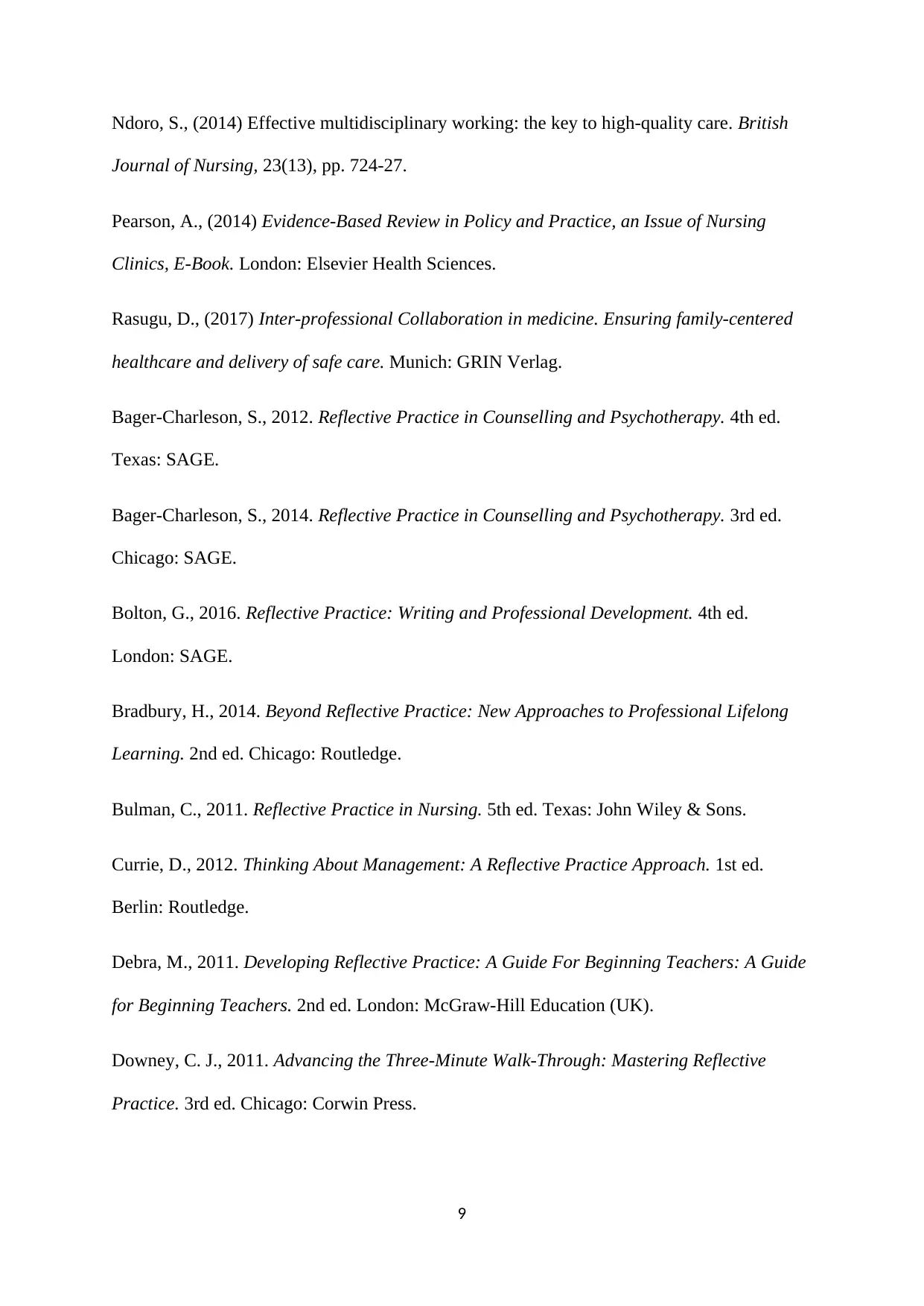
Ndoro, S., (2014) Effective multidisciplinary working: the key to high-quality care. British
Journal of Nursing, 23(13), pp. 724-27.
Pearson, A., (2014) Evidence-Based Review in Policy and Practice, an Issue of Nursing
Clinics, E-Book. London: Elsevier Health Sciences.
Rasugu, D., (2017) Inter-professional Collaboration in medicine. Ensuring family-centered
healthcare and delivery of safe care. Munich: GRIN Verlag.
Bager-Charleson, S., 2012. Reflective Practice in Counselling and Psychotherapy. 4th ed.
Texas: SAGE.
Bager-Charleson, S., 2014. Reflective Practice in Counselling and Psychotherapy. 3rd ed.
Chicago: SAGE.
Bolton, G., 2016. Reflective Practice: Writing and Professional Development. 4th ed.
London: SAGE.
Bradbury, H., 2014. Beyond Reflective Practice: New Approaches to Professional Lifelong
Learning. 2nd ed. Chicago: Routledge.
Bulman, C., 2011. Reflective Practice in Nursing. 5th ed. Texas: John Wiley & Sons.
Currie, D., 2012. Thinking About Management: A Reflective Practice Approach. 1st ed.
Berlin: Routledge.
Debra, M., 2011. Developing Reflective Practice: A Guide For Beginning Teachers: A Guide
for Beginning Teachers. 2nd ed. London: McGraw-Hill Education (UK).
Downey, C. J., 2011. Advancing the Three-Minute Walk-Through: Mastering Reflective
Practice. 3rd ed. Chicago: Corwin Press.
9
Journal of Nursing, 23(13), pp. 724-27.
Pearson, A., (2014) Evidence-Based Review in Policy and Practice, an Issue of Nursing
Clinics, E-Book. London: Elsevier Health Sciences.
Rasugu, D., (2017) Inter-professional Collaboration in medicine. Ensuring family-centered
healthcare and delivery of safe care. Munich: GRIN Verlag.
Bager-Charleson, S., 2012. Reflective Practice in Counselling and Psychotherapy. 4th ed.
Texas: SAGE.
Bager-Charleson, S., 2014. Reflective Practice in Counselling and Psychotherapy. 3rd ed.
Chicago: SAGE.
Bolton, G., 2016. Reflective Practice: Writing and Professional Development. 4th ed.
London: SAGE.
Bradbury, H., 2014. Beyond Reflective Practice: New Approaches to Professional Lifelong
Learning. 2nd ed. Chicago: Routledge.
Bulman, C., 2011. Reflective Practice in Nursing. 5th ed. Texas: John Wiley & Sons.
Currie, D., 2012. Thinking About Management: A Reflective Practice Approach. 1st ed.
Berlin: Routledge.
Debra, M., 2011. Developing Reflective Practice: A Guide For Beginning Teachers: A Guide
for Beginning Teachers. 2nd ed. London: McGraw-Hill Education (UK).
Downey, C. J., 2011. Advancing the Three-Minute Walk-Through: Mastering Reflective
Practice. 3rd ed. Chicago: Corwin Press.
9
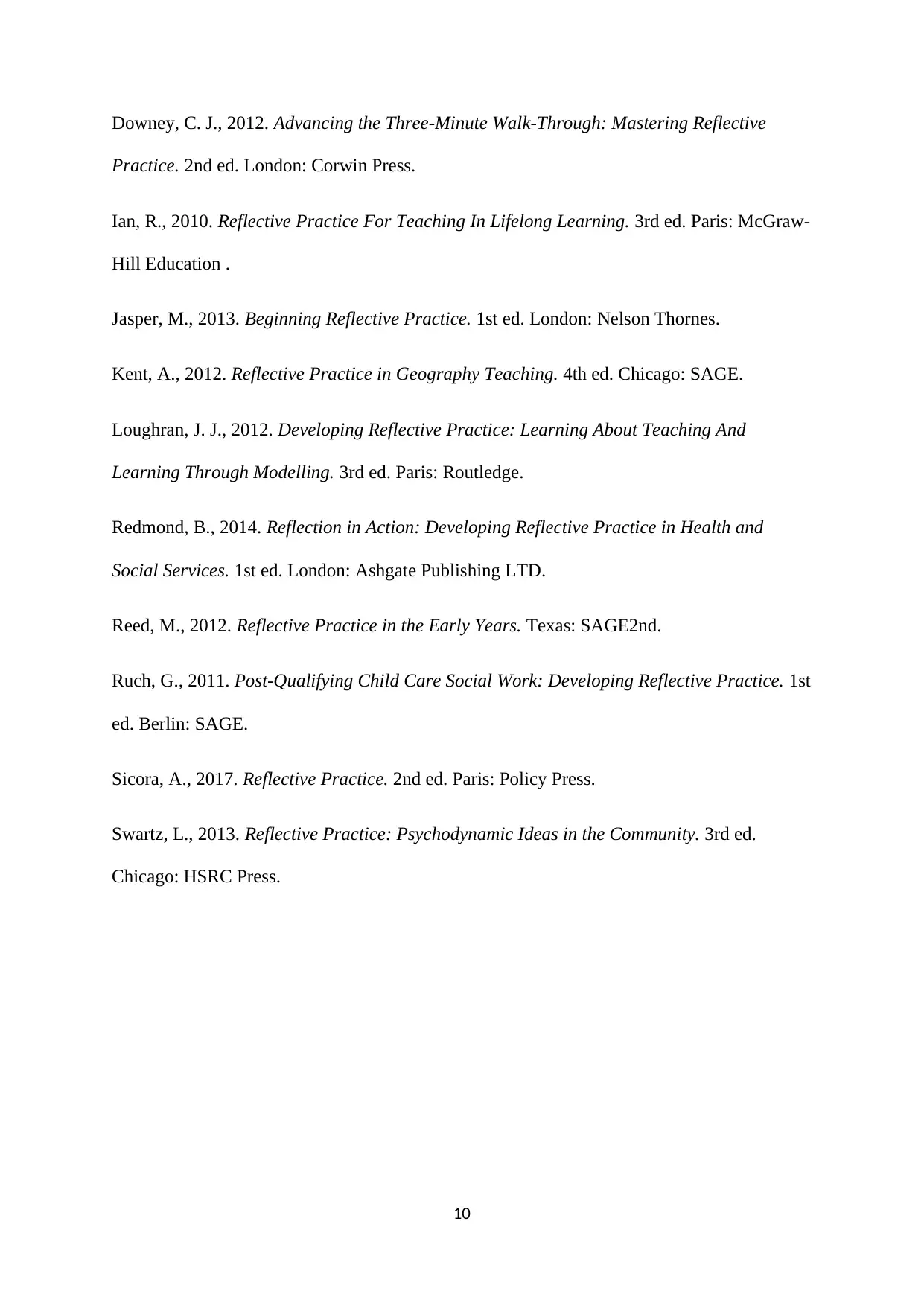
Downey, C. J., 2012. Advancing the Three-Minute Walk-Through: Mastering Reflective
Practice. 2nd ed. London: Corwin Press.
Ian, R., 2010. Reflective Practice For Teaching In Lifelong Learning. 3rd ed. Paris: McGraw-
Hill Education .
Jasper, M., 2013. Beginning Reflective Practice. 1st ed. London: Nelson Thornes.
Kent, A., 2012. Reflective Practice in Geography Teaching. 4th ed. Chicago: SAGE.
Loughran, J. J., 2012. Developing Reflective Practice: Learning About Teaching And
Learning Through Modelling. 3rd ed. Paris: Routledge.
Redmond, B., 2014. Reflection in Action: Developing Reflective Practice in Health and
Social Services. 1st ed. London: Ashgate Publishing LTD.
Reed, M., 2012. Reflective Practice in the Early Years. Texas: SAGE2nd.
Ruch, G., 2011. Post-Qualifying Child Care Social Work: Developing Reflective Practice. 1st
ed. Berlin: SAGE.
Sicora, A., 2017. Reflective Practice. 2nd ed. Paris: Policy Press.
Swartz, L., 2013. Reflective Practice: Psychodynamic Ideas in the Community. 3rd ed.
Chicago: HSRC Press.
10
Practice. 2nd ed. London: Corwin Press.
Ian, R., 2010. Reflective Practice For Teaching In Lifelong Learning. 3rd ed. Paris: McGraw-
Hill Education .
Jasper, M., 2013. Beginning Reflective Practice. 1st ed. London: Nelson Thornes.
Kent, A., 2012. Reflective Practice in Geography Teaching. 4th ed. Chicago: SAGE.
Loughran, J. J., 2012. Developing Reflective Practice: Learning About Teaching And
Learning Through Modelling. 3rd ed. Paris: Routledge.
Redmond, B., 2014. Reflection in Action: Developing Reflective Practice in Health and
Social Services. 1st ed. London: Ashgate Publishing LTD.
Reed, M., 2012. Reflective Practice in the Early Years. Texas: SAGE2nd.
Ruch, G., 2011. Post-Qualifying Child Care Social Work: Developing Reflective Practice. 1st
ed. Berlin: SAGE.
Sicora, A., 2017. Reflective Practice. 2nd ed. Paris: Policy Press.
Swartz, L., 2013. Reflective Practice: Psychodynamic Ideas in the Community. 3rd ed.
Chicago: HSRC Press.
10
1 out of 10
Related Documents
Your All-in-One AI-Powered Toolkit for Academic Success.
+13062052269
info@desklib.com
Available 24*7 on WhatsApp / Email
![[object Object]](/_next/static/media/star-bottom.7253800d.svg)
Unlock your academic potential
© 2024 | Zucol Services PVT LTD | All rights reserved.





